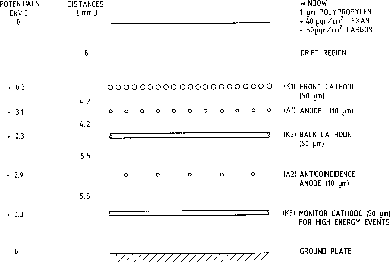




Next: 3.2 Operation
Up: Position-Sensitive Proportional Counter (PSPC)
Previous: Position-Sensitive Proportional Counter (PSPC)
[Aschenbach
et al.1985]
Two redundant position-sensitive proportional counters
(PSPC-B and PSPC-C) are mounted on a carousel within
the focal plane turret of the ROSAT XRT\
(Fig. 2.1).
Two flight-spare detectors (PSPC-A and PSPC-D) were also constructed
and used for some of the ground calibration measurements.
PSPC-C was to be the primary detector for the mission
and was used for the PVC phase and the bulk of the
all-sky survey until its destruction during the
solar slew following an AMCS glitch on 1991 January 25
(Sect. 1.2.2).
The reserved PSPC-B detector was used thereafter (and hence during all
AO pointed observations except those performed during the PVC phase).

Figure 3.1:
Schematic cross-sectional view of a ROSAT PSPC.
The mutually perpendicular cathode grids (K1 and K2) are gold-plated
molybdenum wires with a 0.5 mm spacing used to determine the
position of events (Sect. 3.5.3).
The A1 anode grid consists of gold-plated tungsten wires
of 1 mm separation used to determine the energy of events
(Sect. 3.5.3).
The A2 anode is of identical construction as A1 (except with
a 2 mm wire separation) and used as an anti-coincidence counter.
The filling gas is a mixture of 65% argon, 20% xenon
and 15% methane
[Aschenbach
et al.1985].
The PSPCs
(Fig. 3.1)
are multiwire proportional counters developed by MPE.
Each consists of essentially two separate counters:
the anode A1 with the cathodes K1 and K2 as the position sensing,
X-ray sensitive counter, and
the anode A2 as the anticoincidence counter for background rejection.
Each electrode is a wire grid, with the wires bonded onto a ceramic
support frame.
The anode grids have gold-plated tungsten wires,
 in diameter and a
spacing of 1.5 mm and 2 mm for A1 and A2, respectively.
At the edges of the anode grids are guard wires with
increasing diameters to lower the electric field.
The cathode grids are made of platinum iridium wires,
50
in diameter and a
spacing of 1.5 mm and 2 mm for A1 and A2, respectively.
At the edges of the anode grids are guard wires with
increasing diameters to lower the electric field.
The cathode grids are made of platinum iridium wires,
50  in diameter and with 0.5 mm spacing.
The cathodes are grouped by seven or eight for signal processing.
in diameter and with 0.5 mm spacing.
The cathodes are grouped by seven or eight for signal processing.





Next: 3.2 Operation
Up: Position-Sensitive Proportional Counter (PSPC)
Previous: Position-Sensitive Proportional Counter (PSPC)
If you have problems/suggestions please send mail to
rosat_svc@mpe-garching.mpg.de
